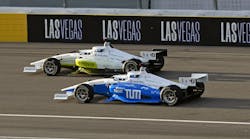Well, the 107th running of the Indy 500 is in the history books. Watching car racing is like following technology. It’s never boring and sometimes it’s downright adrenaline pumping like the tire flying off the race car this year. The tire flew over the crowd and landed in a parking lot damaging a parked car, but no one was hurt. It was an exciting race, which is what makes the event so electrifying. Speaking of electrifying, what about those Formula E races.
This year marks Formula E’s 9th season. Officially it’s called the ABB FIA Formula E World Championship, and you can download smartphone apps for tracking the action. Years ago, I was at a T&D conference and saw a Formula E race car sitting on the floor. It caught my attention because e-racing gives electric vehicle (EV) technologies the racer’s edge.
The racetrack has demonstrated that it’s the toughest test site available when it comes to new applications, but those that prove themselves improve the overall product. The simple rear view mirror was introduced on the racetrack as were disc-brakes. Racing teams look for an edge to beat their opponents and advanced technologies do that.
EPerformance
Formula E racing is doing that in many ways with its ePerformance applications. Their 9th season has started, and the GEN3 formula E car was introduced with its 350 kW (469-hp) motor, but it doesn’t stop there. These machines are lighter, faster, and designed specifically for street racing, Grand Prix style, not drag racing.
When electric motors were added to each wheel, it redefined all-wheel drive. Innovations in regenerative braking systems provided power back to the battery and extended miles-per-watt capabilities. The future of ultra-fast chargers, recyclable batteries, and new composite body materials are in the racetrack’s testing laboratories right now.
Researching these future applications led me to a branch of the digital family tree that has been on pit row for many years, but hasn’t grabbed headlines. If you look closely, you’ll see digital twin technology, predictive analytics, and sophisticated software. A closer view reveals that machine learning, algorithms, and other trappings of artificial intelligence (AI) are also evident. Racing teams are tapping into technology’s edge big time.
More Awareness
Have you heard of the Indy Autonomous Challenge (IAC)? Keeping it simple, the IAC website said it’s a high-speed self-driving car racing event to challenge advanced technologies. These are not EVs, they use internal combustion engines with all of the standard accoutrements found in the typical Indy race cars. The student-teams add optical GPS-units, optical sensors, LiDAR, radars, supercomputer, cutting-edge AI algorithms, etc. to make these race cars fully autonomous.
These races have been taking place for several years and some experts are saying the competition is pushing the boundaries of fully autonomous driving platforms. These vehicles are the most advanced in the world and are capable of operating at high speeds on the demanding racecourse with other autonomous race cars, but imagine this technology applied to drones. It would be a game changer for vegetation and wildfire surveys along rights-of-ways not to mention storm-recovery efforts.
Autonomous Drones
When will autonomous drones be available for power line surveys? With the advancements being made in autonomous vehicle platforms, that’s a question that keeps popping up. Presently, the Federal Aviation Administration (FAA) only allows Uncrewed Aircraft Systems (UAS) to be operated within the pilot’s line of sight and must remain under 400 ft (122 m).
The FAA has been investigating the possibility of operating autonomous drones to operate beyond visual line-of-sight (BVLOS). Some waivers have been issued and several utilities have taken part. Currently UAS BVLOS is still in the realm of no-can-do, but that may be changing. Last year the FAA’s Aviation Rulemaking Committee (ARC) finalized its report titled “UAS BVLOS ARC.”
The report recommends expanding UAS BVLOS with lots of caveats and training requirements. The ARC recognizes the knowledge gained in the waivered programs and improvements in the technologies involved. It also acknowledges the economic and societal benefits UAS BVLOS offers many businesses such as the power delivery industry. There is still a long way to go, but the report lays out a logical progression to achieving UAS BVLOS!
Drones need to be able to fly BVLOS to make a difference in our world of new normals due to climate change. Vegetation management needs this ability in its toolbox to keep up with wildfires and extreme weather events. We have the technology, now we need regulatory support to make it happen.


